If you’re out on a hike, or just poking around the back 40, you’re likely to see mushrooms growing from trees in the woods. Some of them are edible, some aren’t. For the purposes here, I’ve gathered useful, common mushrooms you can eat, since that’s what I’m usually looking for.

It’s important to know that the title is a little misleading. While mushrooms may appear to grow on trees, what we see is only the fruiting body that will eventually make spores and attempt to reproduce. The mushroom life force, or mycelium, is inside of the tree, waiting for the right conditions (temperature, rain, and seasonality) to fruit.
Table of Contents
- Mushrooms That Grow on Living Trees
- Oyster Mushrooms (Pluerotus and others)
- Chicken of the Woods (Laetiporus)
- Hen of the Woods or Maitake Mushrooms (Grifola frondosa)
- Resinous Polypore (Ischnoderma resinosum)
- Hericiums
- Enokitake (Flammulina velutipes)
- Pheasant Back (Cerioporus squamosus)
- Wood Ear (Auricularia judae)
- Witches Butter (Tremella mesenterica)
- Mushrooms That Prefer Dead Trees
- Tree Feeding Mushrooms and Other Fungi
Mushrooms That Grow on Living Trees
Most of the mushrooms I look for that grow on trees grow on living, or injured trees. As you’ll see, there is some overlap between the two. Here’s a few very common mushrooms you might see on your next hike.
Oyster Mushrooms (Pluerotus and others)
Oyster mushrooms (Pluerotus species and relatives) are some of the most common mushrooms found on trees. Most of these are easy to identify, and all are edible with no poisonous mushroom look alikes.
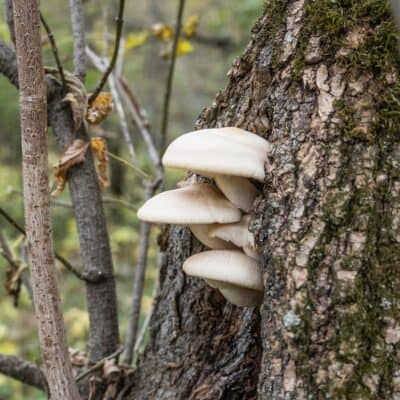
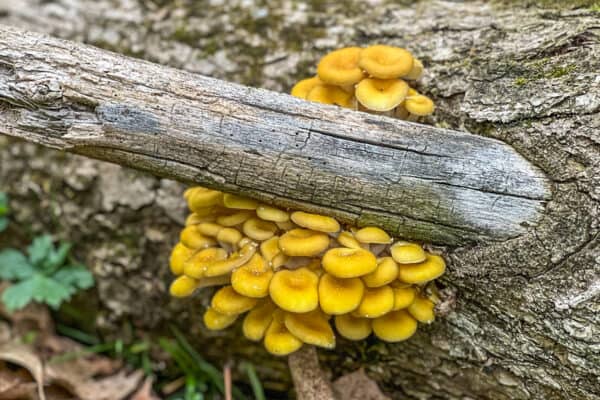



Depending on where you are and what kind of trees are in your area, there can be a number of different species to look for. All oyster mushrooms have gills and white spore prints.
- Elm oyster mushrooms (Hypsizygus ulmarius) grow on elm trees and box elder.
- Aspen oyster mushroom (Pluerotus populina) grows on aspen.
- Pluerotus dryinus is found late in the season growing on oak and beech.
- Late Fall Oyster (Sarcomyxa serotina or Mukitake) is eaten in Japan. There’s been confusion over claims it contains carcinogens, but that information has been disproven and the mushroom is fine to eat. Reference.
- Golden Oyster Mushrooms are a new, invasive species that grows on elms, cherry and other hardwoods.
Chicken of the Woods (Laetiporus)

Chicken of the woods are extremely common, edible, and found around the world. They grow from living and dead trees, stumps, and over roots. Depending on the species they can grow from coniferous or deciduous trees. There’s a number of species, and all of them are edible, with caution. Read more about them in my post Chicken of the Woods Mushrooms.
Hen of the Woods or Maitake Mushrooms (Grifola frondosa)

Similar to chicken of the woods, maitake are a parasite of trees, typically white and red oak, but occasionally on maple. They cause a butt rot in the host tree, and are common on stumps, downed trees, and living trees.
Long appreciated in Japan where they’re known as maitake (dancing mushroom) they’re edible, delicious, and widely appreciated by many foragers East of the Rocky Mountains. Read more about them in my post on Hen of the Woods.
Resinous Polypore (Ischnoderma resinosum)
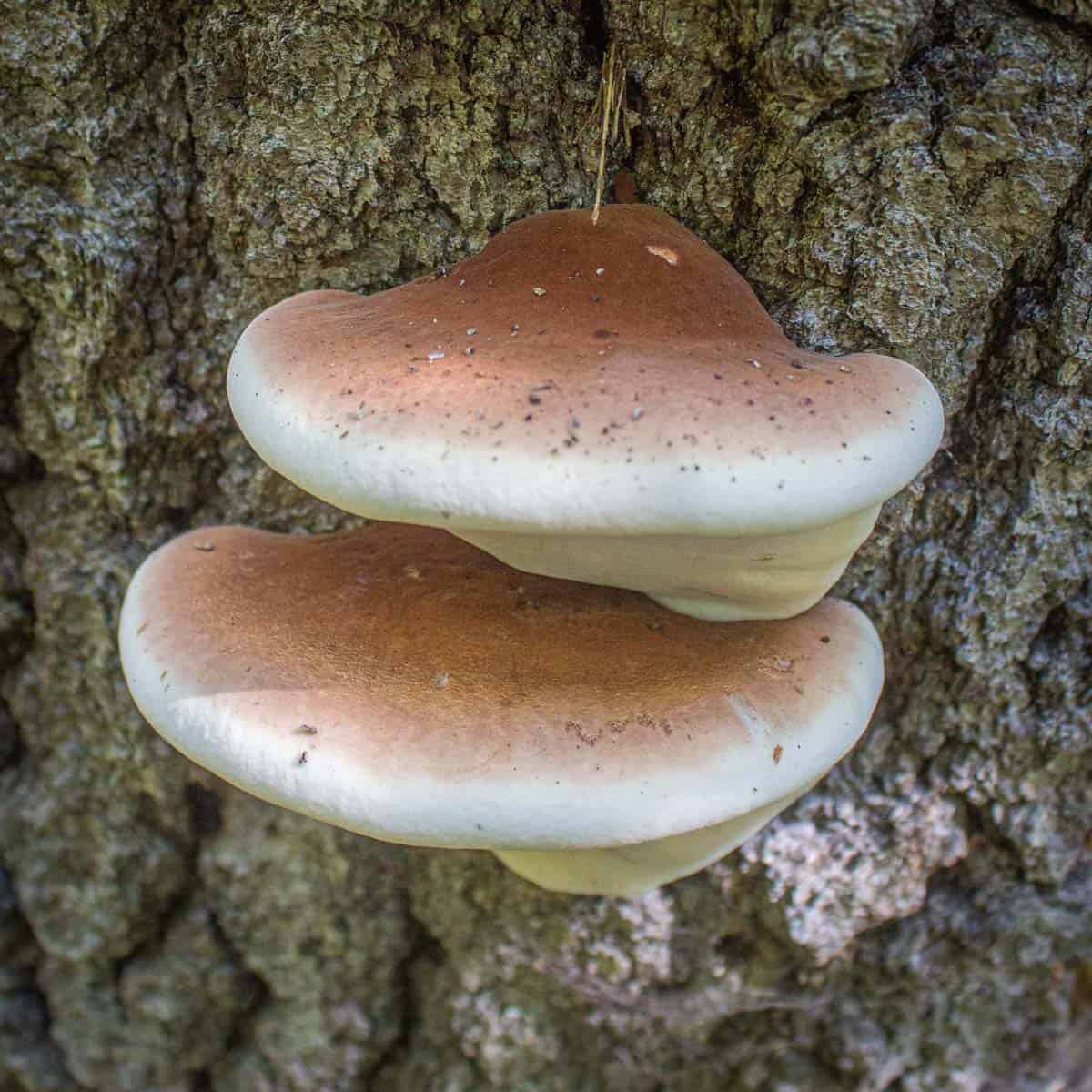
This common parasite of hardwood trees appears in the summer and is common on oaks. It’s a good mushroom for foragers to know as it’s edible and underappreciated, meaning it tastes great, but not a lot of people harvest it.
Some people call it salisbury steak of the woods, or beef of the woods, and that’s a pretty good comparison. Read more about them in my post on Resinous Polypore/Ischnoderma resinosum.
Hericiums
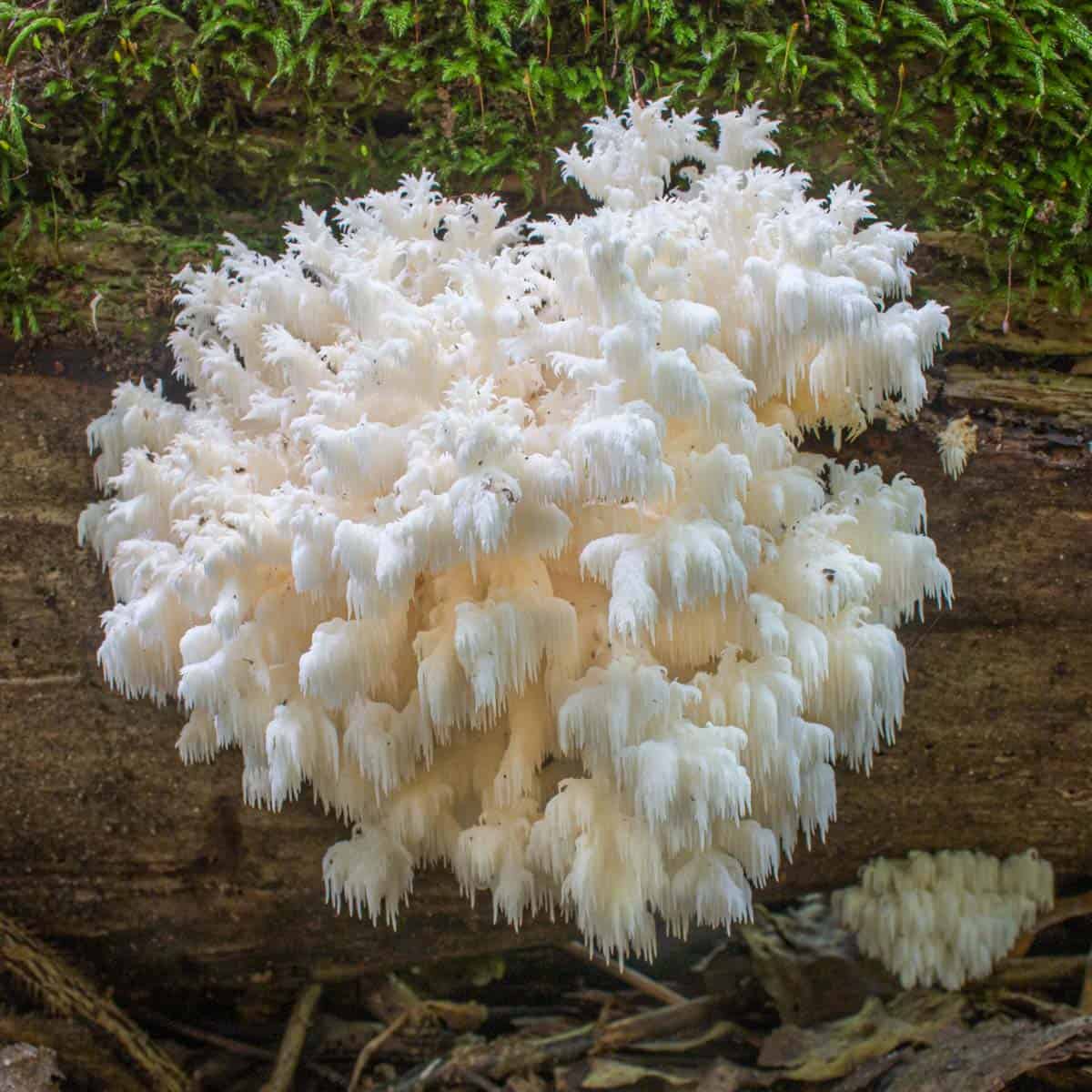
The genus Hericium includes lions mane and its cousins is commonly found on dying oak trees. While the coral tooth fungus (Hericium coralloides) and bearded tooth mushroom (Hericium americanum) seem to prefer dying and fallen oak trees covered in moss, lions mane (Hericium erinaceous) also likes to grow on trees that are still standing. All Hericium are edible, and taste great. Read more about them in my post Lions Mane and Hericium Mushrooms.
Enokitake (Flammulina velutipes)

Enokitake, also known as enoki and the velvet shank mushroom, are parasitic, saprobic decomposers of wood, especially elms. These are the same species of edible mushroom found in stores, but have brown stems and a yellow to orangeish cap when exposed to sunlight.
They appear in the Spring and will continue to fruit throughout the year. Make sure to be able to identify Galerina marginata if you plant to eat them. Read more about them in my post on Enokitake or Velvet Shank Mushrooms.
Pheasant Back (Cerioporus squamosus)
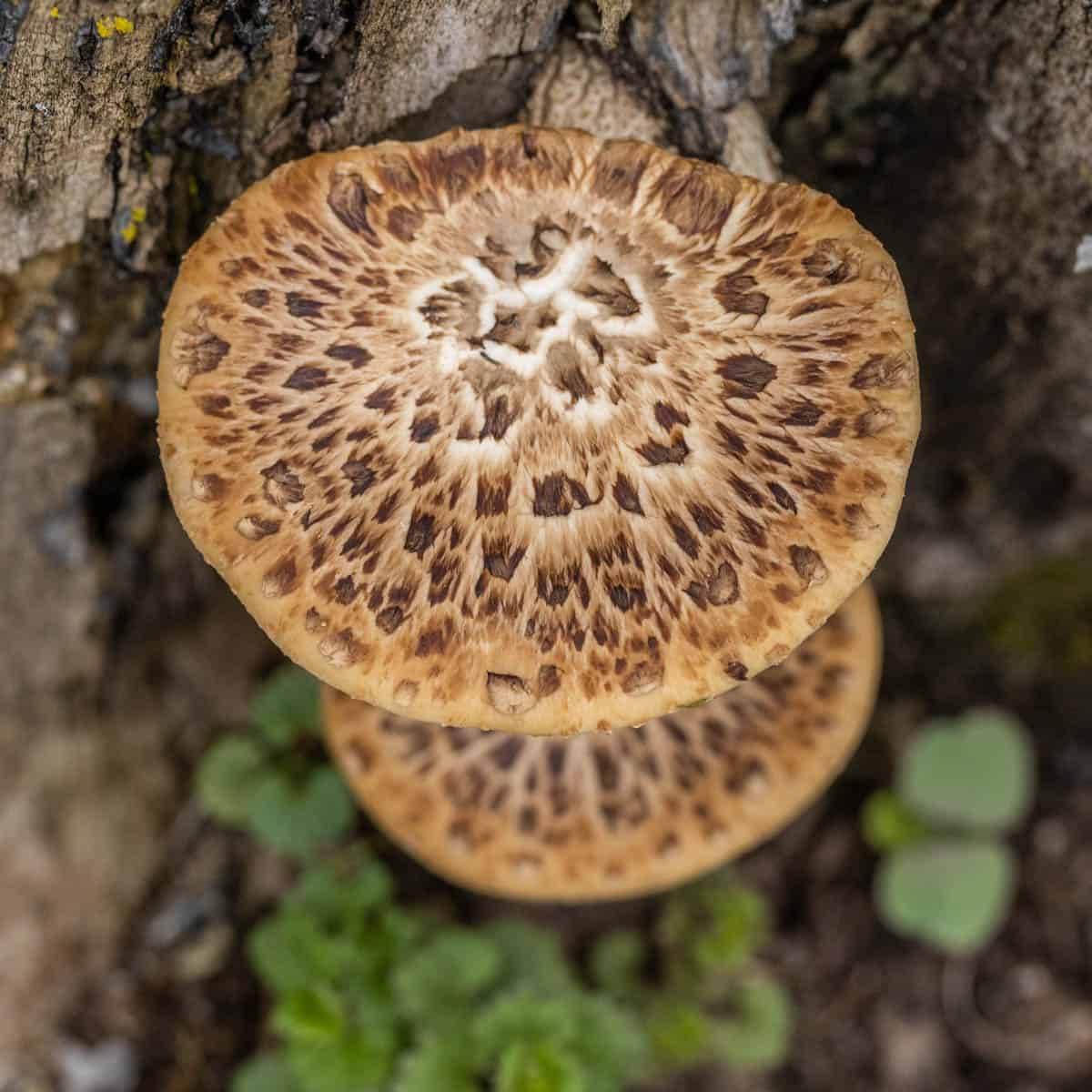
Also known as the dryad saddle, the pheasant back is a parasite and decomposer of hardwood trees, especially box elder and elms. Named for it’s cap scales that resembles pheasant feathers, it’s a common Spring mushroom, but can be found throughout the year.
It’s edible, and tastes very good, but gets tough quickly as it grows so it must be sliced thinly. Read more about them in my post on Dryad Saddle or Pheasant Back Mushrooms.
Wood Ear (Auricularia judae)

Wood Ear Mushrooms, also known by the outdated name of “Jews Ear” are a common decomposer of hardwood trees, often seen growing on branches. Long enjoyed in Asian cuisine, they can be added to soups and broths, especially wood ear mushroom ramen.
Witches Butter (Tremella mesenterica)

Another common tree mushroom is witches butter. This is a commonly found yellow jelly fungus often seen on fallen branches. It has a lobed appearance, and is slimy or sticky when wet.
It’s an edible mushroom, and some foragers like to simmer it in sugar syrup to make mushroom jelly candies. If you want to try that, you can substitute them in my recipe for candied black trumpet mushrooms.
Mushrooms That Prefer Dead Trees
Some mushrooms prefer dead or rotting trees over living ones, although some species like Hericium enjoy feeding on both. Here’s two very common ones you might come across.
Turkey tail (Trametes versicolor)

One of the most common mushrooms on trees in North America, and a popular mushroom mostly known for its “medicinal” benefits. Turkey tails are a decomposer of logs and stumps of deciduous trees, and on the rare occasion, coniferous trees. They’re widely used as a medicinal in things like mushroom tinctures.
Crown coral (Artomyces pyxidatus)
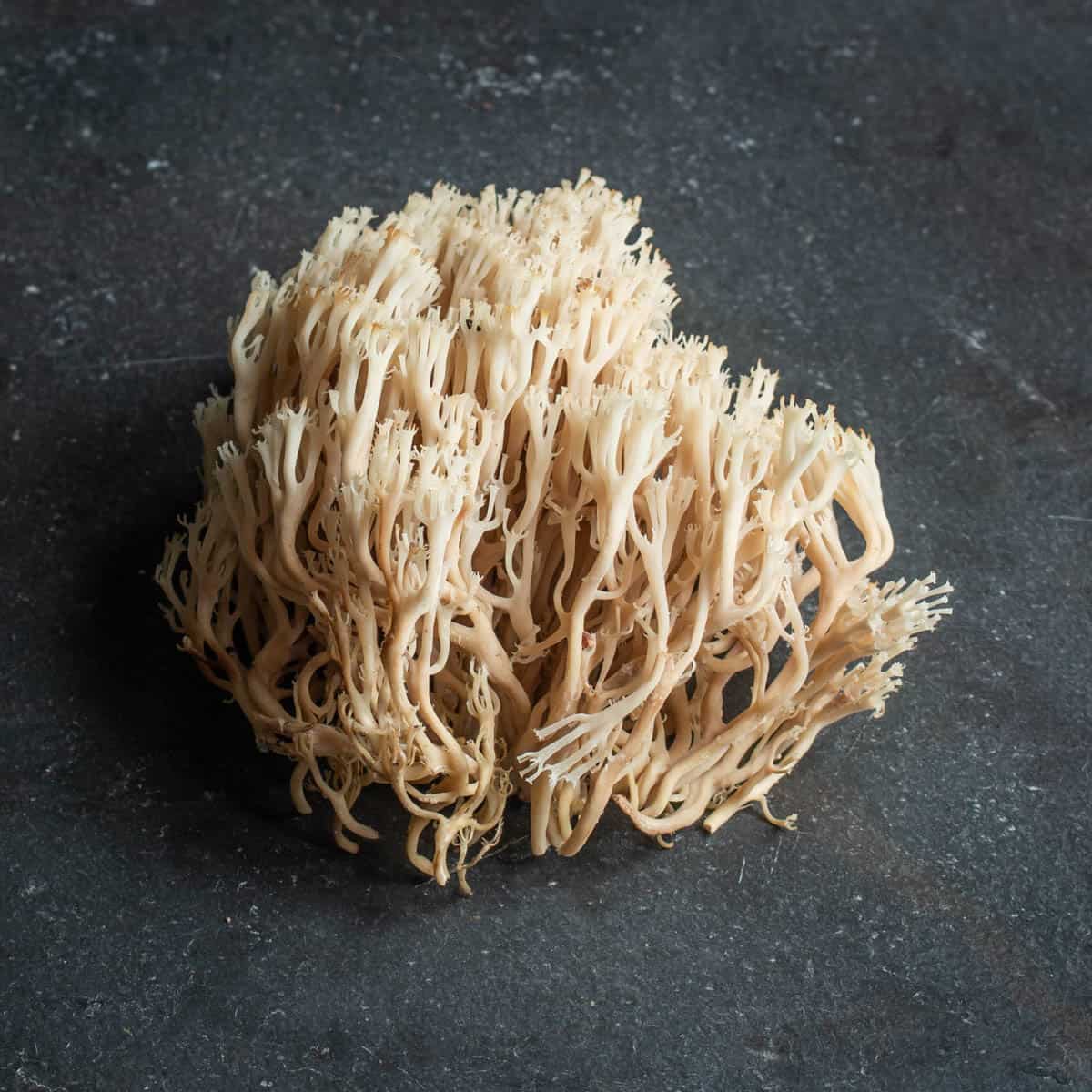
The crown coral mushroom is very common where I live in Minnesota. These only grow from dead, fallen logs that are decaying, and will never grow from live wood. They’re commonly confused with species of coral mushroom or Ramaria, some of which are edible. The key to separating the two genera of fungi is that Ramaria will only grow from the ground, where crown corals only grow from dead and dying wood. Learn more about them in my post on Crown-Tipped Coral Mushrooms.
Tree Feeding Mushrooms and Other Fungi
Besides the mushrooms mentioned here, there’s also many other mushrooms that may grow on trees that you may not notice. One of the most common are crust fungus. There’s many different genera here, including Phlebia, Stereum, and Thelephora. They’re common wood-decomposing fungi.

Another example is cherry knot fungus (Apiosporina morbosa), also known as black knot. It appears as charcoal-like swelling black growths on branches of cherry trees that have been injured, as well as plum trees. Cherry knot fungus will inhibit fruiting, but can be kept in check by regular pruning or fungicides.











































